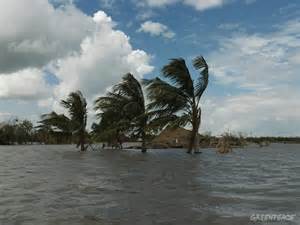
by Carrie Stevenson | Jul 6, 2018
Climate change. Those two simple words have the power to bring about a strong reaction in people. For many, the term is fraught with emotion—with worry, anger, and fear of the unknown. For others, these two words might elicit doubt or frustration. According to a multi-year, nationwide study conducted by George Mason and Yale Universities, as a country we react to the science of climate change along a spectrum of responses. On one end of the spectrum, people are “alarmed” (see a change in climate as a reality and taking action about it) and “concerned” (believe it is a serious issue but have not taken action). In the middle are those in different stages of understanding or awareness of climate issues, and characterized as “cautious”, “disengaged”, or “doubtful.” At the opposite end of the spectrum are the “dismissive”, which are that group of people who are actively opposed to action on climate change and may feel it is a conspiracy. These six categories were based on the responses of a large, in-depth survey conducted in 2008. Ten years later, researchers conducted the study again to see if attitudes had changed. Interestingly, they had—with the most noticeable shift out of the “disengaged” category, as people seemed to cast their lot with one side or the other.
| 2008/2009 |
Yale/George Mason Study Results |
2018 |
| 18% |
Alarmed (+3) |
21% |
| 33% |
Concerned (-3) |
30% |
| 19% |
Cautious (+2) |
21% |
| 12% |
Disengaged (-5) |
7% |
| 11% |
Doubtful (+1) |
12% |
| 7% |
Dismissive (+2) |
9% |
Table 1. 10-year comparison of “Global Warming’s Six Americas” Study. Source: http://climatecommunication.yale.edu/about/projects/global-warmings-six-americas/
Looking at the data, respondents left the “disengaged” group and moved either towards doubtful and dismissive or towards the cautious category. It is likely that the 3% change out of “concerned” moved directly into “alarmed”, as extreme weather events and record temperatures over the last 10 years brought the impacts of a changing climate closer to home.
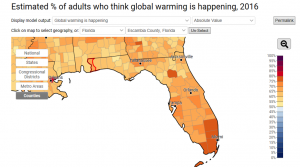
Data from a national study shows the level of agreement/disagreement on climate-based issues. Source: Yale/George Mason University
When the study is broken down by region, a minority of northwest Floridians believed human activities such as carbon emissions caused climate change. However ~65% of the same group believed climate change was happening (regardless of cause), and 80% responded that our country should fund research looking into renewable energy. The good news here is that while many of us do not agree on the cause of climate change, the majority of us agree on positive steps forward that may relieve some of its results.
For me, the take-home message of this study is that scientific understanding—on many issues, not just climate—is often along a spectrum based on exposure to research, personal interest/relevance, and cultural influences. When explaining any science-based concepts, it is important to know where your listener is coming from and start from there. It is unfortunate that we are in a time when many principles of science are taken as political positions and not products of unbiased scientific method. That being said, great thinkers from Galileo to Hawking have had their run-ins with popular opinion.
As the summer heat cooks on and hurricane season warms up, there will be more articles in the news about climate and its effects. When reading these, look at the source and their intent. Is this an opinion piece/blog with deeply emotional photos and stories meant to sway readers one way or the other? Or is it an agency page, reporting factual data? Time-tested agencies like the National Weather Service (NWS), National Oceanic and Atmospheric Administration (NOAA) and National Aeronautic and Space Administration (NASA) have been keeping historic records of climate data and satellite imagery of ice cover for decades. Use their information to inform yourself, no matter where you might fall upon the “six Americas” spectrum. Worldwide data for climate has been kept since 1880, and both NASA and NOAA climate data found:
- 2016 was the hottest year globally on record
- 2nd and 3rd hottest years on record were 2015 and 2014.
- 16 of the 17 warmest years documented since 1880 have been since 2001
For more information on climate science, check out these resources: Intergovernmental Panel on Climate Change, NOAA Climate, and NASA Climate.

by Chris Verlinde | Jun 23, 2018
As the heat indicies rise, there a number of organizations that offer great learning experiences about our local Natural Resources!! While it is great to have the outdoor hands-on learning, the afternoon heat can feel suffocating. Here are a couple of nature centers that you can visit to get out of the heat.
Apalachicola National Estuarine Research Reserve is home to the Reserve’s Nature Center, located at 108 Island Drive, in East Point Florida. Inside the air-conditioned Nature Center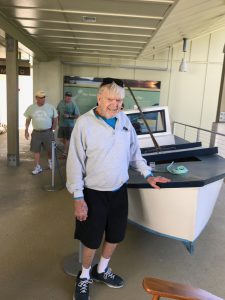 are many interactive displays and tanks with live local animals. At one end of the center, there is a large mural that takes you from the upper-parts of the Apalachicola River to the Gulf of Mexico, There are many native animals identified on the mural. There is an area with plenty of artifacts to keep the young and old naturalist busy.
are many interactive displays and tanks with live local animals. At one end of the center, there is a large mural that takes you from the upper-parts of the Apalachicola River to the Gulf of Mexico, There are many native animals identified on the mural. There is an area with plenty of artifacts to keep the young and old naturalist busy.
The interactive cultural displays are really interesting and provide much information about the fishing industry that Apalachicola is known for throughout Florida.
The Reserve features a many trails that lead throughout the property and many to the water. The Apalachicola National Estuary Reserve is one of 29 National Estuarine Research Reserves in the U.S. Each reserve is protected for “long-term research, water quality and habitat monitoring, education, and coastal stewardship.”
The Reserve is open to the public Tuesday through Saturday from 9 am until 4 pm, admission is free.
Photos provided by Chris Verlinde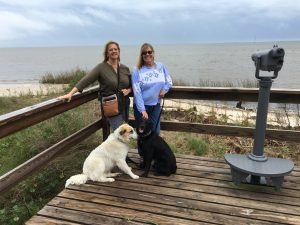 Heading to the west, near the town of Freeport Florida, you will find the E.O. Wilson Biophilia Nature Center. This amazing place will keep you and your family entertained for hours. If you plan to go, the center is only open to the public on Thursday and Friday during June and July from 9 am until 2 pm. The cost is $8.00 for adults, $5.00 for children ages 3-12 and free for those 2 and under. The rest of the year, the staff are dedicated to teaching local students from surrounding school districts about biodiversity in Northwest Florida. As you enter the exhibit building there is a tribute to the famous naturalist E.O Wilson, whose work is the inspiration for center. Dr. Wilson is dedicated to teaching others about the importance of conservation of biodiversity. He coined the term “biophilia” which means “the love of all living things.” The exhibit hall features many different displays on the cultural and natural resources in the area. The center features a reptile room, classrooms, an amphitheater, porches to enjoy your lunch and the “World of Wonder Exhibit.” which is a Science on a Sphere – a giant globe that utilizes technology to teach about the planets, our weather, and more.
Heading to the west, near the town of Freeport Florida, you will find the E.O. Wilson Biophilia Nature Center. This amazing place will keep you and your family entertained for hours. If you plan to go, the center is only open to the public on Thursday and Friday during June and July from 9 am until 2 pm. The cost is $8.00 for adults, $5.00 for children ages 3-12 and free for those 2 and under. The rest of the year, the staff are dedicated to teaching local students from surrounding school districts about biodiversity in Northwest Florida. As you enter the exhibit building there is a tribute to the famous naturalist E.O Wilson, whose work is the inspiration for center. Dr. Wilson is dedicated to teaching others about the importance of conservation of biodiversity. He coined the term “biophilia” which means “the love of all living things.” The exhibit hall features many different displays on the cultural and natural resources in the area. The center features a reptile room, classrooms, an amphitheater, porches to enjoy your lunch and the “World of Wonder Exhibit.” which is a Science on a Sphere – a giant globe that utilizes technology to teach about the planets, our weather, and more.
Animals that can be found at the center include: birds of prey, bobcats, turtles and snakes, a red-cockaded woodpecker, a fox, and chickens. A short walk outside, you will find an authentic cracker house (with snakes!) and an organic garden.
The E.O. Wilson Biophilia center is a wonderful place to visit, check it out soon!!
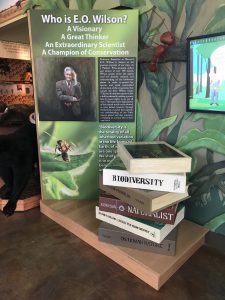
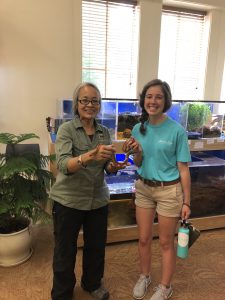
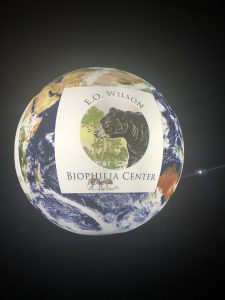
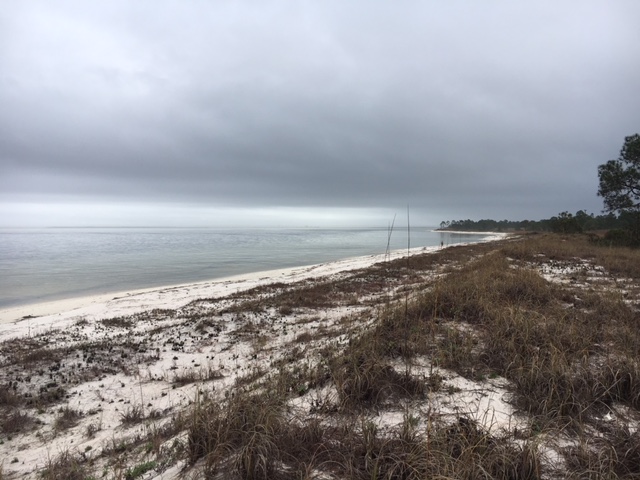
by Rick O'Connor | Jun 22, 2018
What is bioaccumulation of toxins?
Our bodies come in contact, and produce, toxins every day. The production of toxins can result during simple metabolism of food. However, our bodies are designed with a system to rid us of these toxins. Toxins are processed by our immune system and removed via our kidneys. Some chemical compounds are structured in a way that they are not as easily removed, thus they accumulate in our bodies over time, often in fatty tissues, and sometimes they are toxic – this is bioaccumulation.
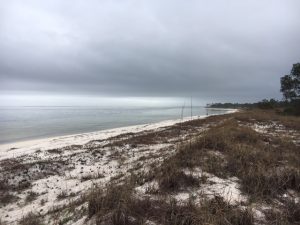
A view of Pensacola Bay from Santa Rosa Island.
Photo: Rick O’Connor
Biomagnification takes it a step further. In many cases, the concentrations of bioaccumulating toxic substances in the water may be in low enough concentrations to have little effect on human health. They are ingested by small organisms in the environment, such as plankton or juvenile marine fish, and – again are at low concentrations. However, they are accumulated in their tissues and as the next level of the food chain begin to consume them – they too accumulate the toxic compounds in their tissues. Small fish consume large amounts of plankton and thus, large amounts of the toxins they have accumulated – increasing the concentration within their own tissues. This continues up the food chain to a point where, in the larger predators, the concentrations of these toxins have increased enough that they now pose a threat to human health – this is biomagnification.
The presence, and amount, of any one bioaccumulating compound varies with species, their size, their age, their gender, their life stage, whether they are mobile or not, their diet, and whether the sample included the skin (which is lipid heavy and a common location for accumulated toxins). In the Pensacola Bay System, about 30 species of marine plants and animals have been analyzed for the presence of these accumulating compounds.
Species collected from Pensacola Bay that were analyzed for contaminants
| Plants |
3 species of seagrass
1 species of seaweed
Colonized algal periphyton |
| Invertebrates |
4 species of freshwater mussels
Eastern oyster
1 species of brackish water clams
1 species of barnacle
Several species of shrimp
Blue crab
Oyster drill (snail) |
| Vertebrates |
2 species of catfish
5 species of scaienids (drums, croakers, trout)
Bluegill
Bluefish
Several species of flounder
2 species of jacks
Largemouth bass
Sheepshead
Striped mullet |
Trace Metal Accumulation
Much of what has been studied in terms of metal accumulation has come from shellfish – particularly eastern oysters. Ten different metals have been found in oysters with zinc being in the highest concentration and lead the lowest. A 2005 study found that levels of arsenic, lead, and nickel collected from mussels collected at selected locations in the PBS were regionally high (meaning higher than other estuaries in the region). Another study (2003) found that levels of 16 different metals in shellfish were three times higher in Bayou Chico than samples from East Bay. A 1993 study found that organisms attached to pieces of treated wood in Santa Rosa Sound had elevated levels of metals. However, another study (2008) found low concentrations of metals in five species of fish collected in Escambia Bay near the I-10 Bridge.
The bioaccumulation potential within plants is less understood than animals. That said – concentrations within seagrass were relatively low when compared to the sediments they were growing in and periphytic algae attached to them.
Total Mercury Concentrations (ng/g – dry weight) for Local Marine Organisms
Lewis and Chaney (2008)
| Range (ng/g) |
Species |
| 0-200 |
Sediments, seagrass, oysters |
| 200 – 400 |
Periphytic algae |
| 400 – 600 |
Mussels |
| 600 – 800 |
Brackish clams, blue crabs |
| 800 and higher |
Fish |
The above table shows biomagnification.
Comparing trace metal concentrations between Pensacola Bay and other Regional Estuaries
(USEPA unpublished data)
| Pensacola Bay, Escambia Bay, Escambia River, Bayou Texar, Bayou Chico, Bayou Grande, Santa Rosa Sound |
Grand Lagoon (Bay Co.), Mississippi Sound, Old River, Suwannee River, Withlacoochee River, Bay La Launch |
| Cadmium |
Higher in PBS; highest in Bayou’s Grande and Texar |
| Chromium |
Similar to other estuaries |
| Copper |
Slightly elevated in Bayou Chico and Escambia River; highest in Withlacoochee |
| Total Mercury |
Much higher in PBS; particularly in the bayous |
| Nickel |
Lower in PBS |
| Lead |
Higher in PBS; particularly in the bayous |
| Zinc |
Higher in PBS; particularly in the bayous |
There are higher concentrations of trace metals in PBS and particularly in the bayous.
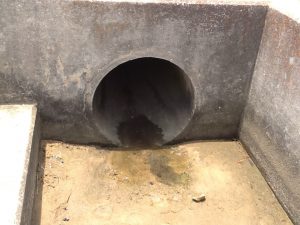
One of 39 stormwater drains into Bayou Texar.
Photo: Rick O’Connor
Non-Nutrient Organic Chemicals
These are compounds such as PCBs, DDT, and PAHs; many are actually families of multiple forms of compounds. Information on the bioaccumulation of these compounds in PBS is less common than those of trace metals. However, this information is important since they have long half-lives and magnify within the food web.
That said – there are studies on these compounds that go back to the 1970’s. They looked at DDT, pesticides, and PAHs in oysters and croakers. One study (1986-96) found DDT concentrations in oysters at 60 ppb or less. A follow up study (2004-05) at those same locations found concentrations between 8-20 ppb. One study (2008) found the order of accumulating non-nutrient organic compounds with PAHs as the highest and dieldrin at the lowest. Downward trends were reported (2004-05) for many of these compounds including PAHs and PCBs.
Some of these compounds have entered the PBS via unlined ponds associated with on-land Superfund sites. Creosote and pentachlorophenol were stored for years in such ponds and have leached into area waters such as Bayou Chico and portions of upper Pensacola Bay. A study (1987-88) found oyster drills sampled in these areas had concentrations 10x higher than reference sites in other parts of the PBS.
So what can we do about this?
The compounds that are there – are there. Many of these trace metals are heavy and sink into the sediments. There occurrence within the food web has decreased over time and some have suggested the safest thing to do is to leave them where they are. No doubt, any project requiring sediment movement requires much review and permitting.
To try to remove these compounds would be extremely expensive – hence the Superfund Program. So if we cannot clean the sediments without a lot of labor and money, can we reduce the amount that enters the bay today?
Many of these compounds come from industrial processing of products we really want or need. Reduction of the production of some will be difficult, but there is much industry can do to reduce the chance of those compounds reaching our estuaries – and they are doing this. Point source pollution (direct discharge from an industry) has reduced significantly since the 1970’s. Non-point sources (indirect discharge from you and I) is still a problem. We can choose products that contain less (or none) of the compounds we discussed. Following an IPM program for dealing with household and lawn pests (see article on Florida Friendly Yards – https://blogs.ifas.ufl.edu/escambiaco/2018/06/08/restoring-the-health-of-pensacola-bay-what-can-you-do-to-help-a-florida-friendly-yard/) can help a lot. As can practices that reduce the amount of run-off reaching our bays. Reducing your use of lawn watering, using rain barrels, or rain gardens, and planting living shorelines (all mentioned in the FFY article) can certainly help.
Reference
Lewis, M.J., J.T. Kirschenfeld, T. Goodhart. 2016. Environmental Quality of the Pensacola Bay System: Retrospective Review for Future Resource Management and Rehabilitation. U.S. Environmental Protection Agency. Gulf Breeze FL. EPA/600/R-16/169.
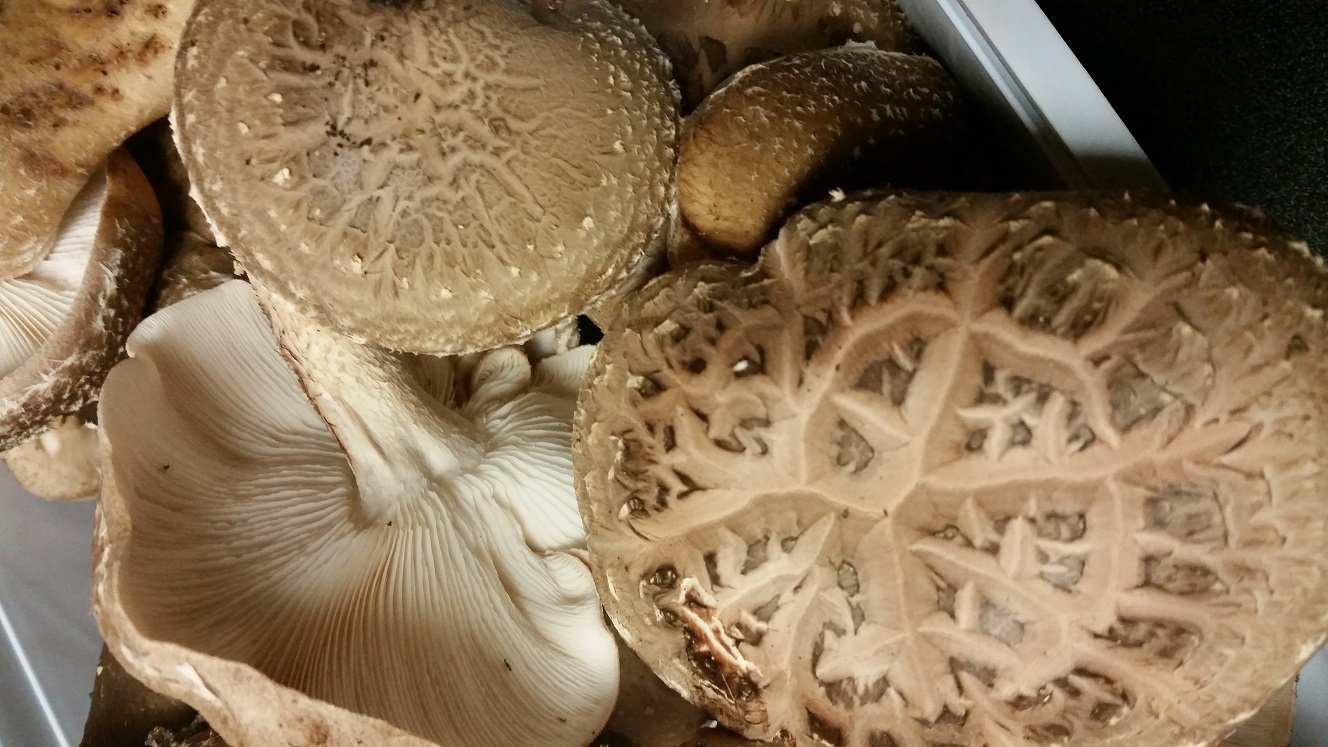
by Erik Lovestrand | Jun 8, 2018
Have you ever eaten a wild mushroom and then wondered afterwards if you might have made a mistake? If you are prone to forage outdoors for tasty treats from nature, I’ll bet you have. The problem is, unless you are harvesting one of a few “foolproof” species of edible fungi, positive identification can be very challenging. Oft-times wild mushroom harvesters take a notion to branch out and seek new varieties that are outside of the identification capabilities of the novice mycologist. This is where folks begin treading on dangerous ground and may be at risk for gastrointestinal distress;
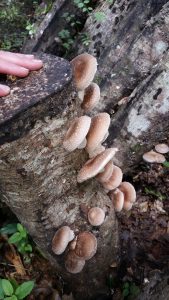
Properly inoculated shiitake logs can be quite productive
with symptoms that may range from a mild upset stomach to permanent damage or death.
Yes, death!
Everyone has heard about poisonous mushrooms but few people realize that some of the deadliest species are look-alikes for some of the tastiest species. And you would not be able to distinguish the difference by nibbling a sample. Even a small sample of some of the “bad actors” can be lethal, leading to painful symptoms and organ failure. If this scares you out taking a risk then this article has served a good purpose.
If you wish to enjoy a safe, tasty experience with a highly-prized mushroom species, just take up the hobby of growing your very own shiitake mushrooms. Shiitake comes from the root Japanese “shii” (meaning oak) and “take” (for mushroom). Shiitake mushrooms are a billion dollar industry in Asia with 92% of the world production coming from Japan. Many culinary and medical uses have been identified. This species was only available as dried mushrooms in the US until 1972 but with the removal of a ban on importing live fungi a commercial industry has blossomed.
Hardwood logs are the key, with oak being a preferred tree species. There are six considerations if you are to be successful:
1. You must acquire living Shiitake inoculum (the mycelial or rooting stage) already growing on a wood medium, usually hardwood dowels or sawdust (internet search will yield many providers).
2. Proper cutting and handling of the logs to be inoculated is important. Cut trees close to the time of inoculation (2 weeks max.), 4-8 inch diameter and 3-4 feet long.
3. Inoculate by drilling holes in the logs, inserting the living inoculum/spawn and seal the holes with melted wax to retain moisture. A single log may have 30-40 holes drilled in it.
4. Place logs in a shady/moist environment (i.e. under the canopy in a woodlot with at least 75% shade).
5. Maintain logs by wetting during dry spells. A sprinkler or mister run for a couple of hours a day works well.
6. Proper harvesting and storage is most important and information is available in many places online.
Shiitake fruiting is usually triggered by changes in temperature and humidity so spring and fall are key times to check your logs. It does not take long for a mushroom to go from the early “pinning” stage to mature, so weekly checks are advised. Significant tropical weather events will also stimulate fruiting. Logs produce mushrooms for at least two years, until the nutrients in the wood are used up.
Don’t be in a hurry though, as the full colonization of the log by the mushroom mycelium will take up to 9 months before mushrooms begin to appear. Remember, beware the risks of harvesting wild fungi. A small-scale shiitake growing operation is a safe alternative for getting your “mushroom-fix.” Also, be ready to compete with a squirrel or two for your crop as they know a good thing when they see it too.
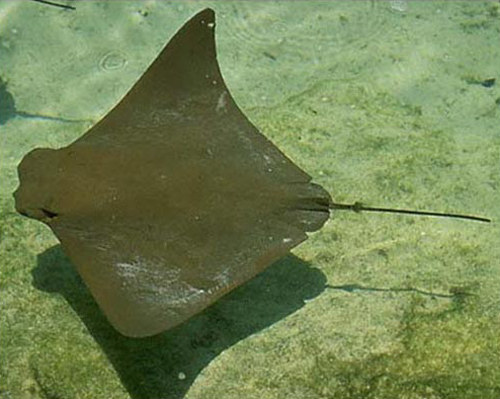
by Rick O'Connor | May 31, 2018
It is now late May and in recent weeks I, and several volunteers, have been surveying the area for terrapins, horseshoe crabs, and monitoring local seagrass beds. We see many creatures when we are out and about; one that has been quite common all over the bay has been the “stingray”.

The cownose ray is often mistaken for the manta ray. It lacks the palps (“horns”) found on the manta.
Photo: Florida Sea Grant
These are intimidating creatures… everyone knows how they can inflict a painful wound using the spine in their tail, but may are not aware that not all “stingrays” can actually use a spine to drive you off – actually, not all “rays” are “stingrays”.
So what is a ray?
First, they are fish – but differ from most fish in that they lack a bony skeleton. Rather it is cartilaginous, which makes them close cousins of the sharks.
So what is the difference between a shark and a ray?
You would immediately jump on the fact that rays are flat disked-shape fish, and that sharks are more tube-shaped and fish like. This is probably true in most cases, but not all. The characteristics that separate the two groups are
- The five gill slits of a shark are on the side of the head – they are on the ventral side (underside) of a ray
- The pectoral fin begins behind the gill slits in sharks, in front of for the ray group
Not all rays have the whip-like tail that possess a sharp spine; some in fact have a tube-shaped body with a well-developed caudal fin for a tail.
There are eight families and 19 species of rays found in the Gulf of Mexico. Some are not common, but others are very much so.
Sawfish are large tube-shaped rays with a well-developed caudal fin. They are easily recognized by their large rostrum possessing “teeth” giving them their common name. Walking the halls of Sacred Heart Hospital in Pensacola, you will see photos of fishermen posing next to monsters they have captured. Sawfish can reach lengths of 18 feet… truly intimidating. However, they are very slow and lethargic fish. They spend their lives in estuaries, rarely going deeper than 30 feet. They were easy targets for fishermen who displayed them as if they caught a true monster. Today they are difficult to find and are protected. There are still sightings in southwest Florida, and reports from our area, but I have never seen one here. I sure hope to one day. There are two species in the Gulf of Mexico.
Guitarfish are tube-shaped rays that are very elongated. They appear to be sharks, albeit their heads are pretty flat. They more common in the Gulf than the bay and, at times, will congregate near our reefs and fishing piers to breed. They are often confused with the electric rays called torpedo rays, but guitarfish lack the organs needed to deliver an electric shock. They have rounded teeth and prefer crustaceans and mollusk to fish. There is only one species in the Gulf.
Torpedo rays can deliver an electric shock – about 35 volts of one. Though there are stories of these shocking folks to death, I am not aware of any fatalities. Nonetheless, the shock can be serious and beach goers are warned to be cautious. I once mistook one buried in the sand for a shell. Let us just say the jolt got my attention and I may have had a few words for this fish before I returned to the beach. We have two species of torpedo rays in the Gulf of Mexico.
Skates look JUST like stingrays – but they lack the whip-like tail and the venomous spine that goes with it. They are very common in the inshore waters of the Florida Panhandle and though they lack the terrifying spine we are all concerned about, they do possess a series of small thorn-like spine on the back that can be painful to the bare foot of a swimmer. Skates are famous for producing the black egg case folks call the “mermaids’ purse”. These are often found dried up along the shore of both the Gulf and they bay and popular items to take home after a fun day at the beach. There are four species of skates found in the Gulf of Mexico.
Stingrays… this is the one… this is the one we are concerned about. Stingrays can be found on both sides of our barrier islands and like to hide beneath the sand to ambush their prey. More often than not, when we approach they detect this and leave. However, sometimes they will remain in the sand hoping not to be detected. The swimmer then steps on their backs forcing them to whip their long tail over and drive the serrated spine into your foot. This usually makes you move off them – among other things. The piercing is painful and spine (which is actually a modified tooth) possesses glands that contain a toxic substance. It really is no fun to be stung by these guys. Many people will do what is called the “stingray shuffle” as they move through the water. This is basically sliding your feet across the sand reducing your chance of stepping on one. They are no stranger to folks who visit St. Joe Bay. The spines being modified teeth can be easily replaced after lodging in your foot. Actually, it is not uncommon to find one with two or three spines in their tails ready to go. Stingrays do not produce “mermaids’ purses” but rather give live birth. There are five species in the Gulf of Mexico.

The Atlantic Stingray is one of the common members of the ray group who does possess a venomous spine.
Photo: Florida Museum of Natural History
Butterfly ray is a strange looking fish and easy to recognize. The wide pectoral fins and small tail gives it the appearance of a butterfly. Despite the small tail, it does possess a spine. However, the small tail makes it difficult for the butterfly ray to pierce you with it. There is only one species in the Gulf, the smooth butterfly ray.
Eagle rays are one of the few groups of rays that actually in the middle of the water column instead of sitting on the ocean floor. They can get quite large and often mistaken for manta rays. Eagle rays lack the palps (“horns”) that the manta ray possesses. Rather they have a blunt shaped head and feed on mollusk. They do have venomous spines but, as with the butterfly ray, their tails are too short to extend and use it the way stingrays do. There are two species. The eagle ray is brown and has spots all over its back. The cownose ray is very common and almost every time I see one, I hear “there go manta rays”… again, they are not mantas. They have a habit of swimming in the surf and literally body surfing. Surfers, beachcombers, and fishermen frequently see them.
Last but not least is the very large Manta ray. This large beast can reach 22 feet from wingtip to wing tip. Like eagle rays, they swim through the ocean rather than sit on the bottom. They have to large “horns” (called palps) that help funnel plankton into their mouths. These horns give them one of their common names – the devilfish. Mantas, like eagle and butterfly rays, do have whip-like tails and a venomous spine, but like the above, their tails are much shorter and so effective placement of the spine in your foot is difficult.
Many are concerned when they see rays – thinking that all can inflict a painful spine into your foot – but they are actually really neat animals, and many are very excited to see them.
References
Hoese, H.D., R.H. Moore. 1977. Fishes of the Gulf of Mexico; Texas, Louisiana, and Adjacent Waters. Texas A&M. College Station, TX. pp. 327.
Shipp, R. L. 2012. Guide to Fishes of the Gulf of Mexico. KME Seabooks. Mobile AL. pp. 250.

by Rick O'Connor | May 25, 2018
In the mid 1990’s, the Bay Area Resource Council was created. This multi-county (Escambia and Santa Rosa) organization included local scientists and decision makers to help better understand the health of Pensacola Bay, develop a plan for restoration, and work collaboratively to acquire funding to do so. At the inaugural meeting, many different scientists spoke on a variety of topics. There were several take-home messages – one of them was that sediments of Pensacola Bay were in poorer health than the water within the water column above it.

Grabs are used by marine scientist to collect samples of sediments from the bottom of the bay.
Photo: Coastal Science NOAA
So, what is wrong with the sediments, and how has this changed since the mid ‘90’s?
Based on sediment sample analysis, some researchers consider the Pensacola Bay System the most polluted in the state of Florida… but not everyone. The three bayous (Chico, Texar, and Grande), Escambia Bay, and the downtown waterfront of Pensacola Bay had some of the poorest sediment samples within the system. Contaminants monitored include trace metals, mercury, non-nutrient organics, pesticides, and dioxins. These contaminants are dense and do not remain in the water column long. Instead, they sink into the sediments. At that time, some suggested that attempts to remove the contaminants could increase their levels within the water column and do more harm than good – thinking it would be better to leave the sediments as they are. Many of the compounds entered the estuary through run-off. In some cases in the past, they were discharged directly into a bay or river.
Chemicals found in Pensacola estuarine sediments include Arsenic, Zinc, and Copper. Mercury levels at some locations in the bay are higher than other estuaries around the northern Gulf region. Some non-nutrient organic compounds were not as high as other local estuaries however; bioaccumulation (the increase in contaminant concentrations via the food chain) has been occurring and should be monitored. Many chemical compounds banned in the 1970’s have long half-lives and are still detected in the sediments today. Chlorinated pesticides, such as dieldrin, chlordane, DDE, DDD, and DDT are still found in the bayous – and at higher concentrations than neighboring estuaries.
This all sounds bad, but are the levels high enough to be toxic to marine organisms?

Herbicides and pesticides can find their way into estuarine systems and contaminate the sediments.
Photo: UF IFAS Washington County Extension
One location, in upper Bayou Texar, seems to be quite toxic to the species of bacteria, invertebrates, fish, and plants tested. These toxic concentrations are partially from chemicals present in run-off, but there is also seepage coming from groundwater contaminated from a nearby Superfund site. Most of the test suggest that the lethal concentrations are more chronic in nature than acute.
So what can be done? What can we do?
Well… removing and treating these sediments is quite expensive and is not an option at this time. There are plans to dredge portions of Bayou Chico but the process has undergone extensive scrutiny and permitting. One thing we can do is reduce the amount that is still entering the bay. How do we do this?
- Consider re-landscaping your yard to be “Florida Friendly”. Using the suggestions given within this University of Florida program (http://fyn.ifas.ufl.edu/) you can reduce the amount of fertilizer, herbicide, and pesticides you use – thus reducing the amount entering the estuaries.
- Florida Friendly Landscaping practices can also reduce the amount of watering your lawn needs. This reduces the amount of run-off reaching the bay and always reduces the amount of money you spend on watering and lawn chemicals.
- The Florida Department of Environmental Protection’s Clean Boater program provides tips and suggestions that reduce the amount of hazardous chemicals that enter the bay from cleaning and maintaining vessels. https://floridadep.gov/fco/cva/content/clean-boater-program.
The sediments of the bay have suffered the abuse of the past. However, with better practices, we can reduce our impact in the future.

Florida Friendly Landscaping saves money and reduces our impact on the estuarine environment.
Photo: UF IFAS
Reference
Lewis, M.J., J.T. Kirschenfeld, T. Goodhart. 2016. Environmental Quality of the Pensacola Bay System: Retrospective Review for Future Resource Management and Rehabilitation. U.S. Environmental Protection Agency. Gulf Breeze FL. EPA/600/R-16/169.




















